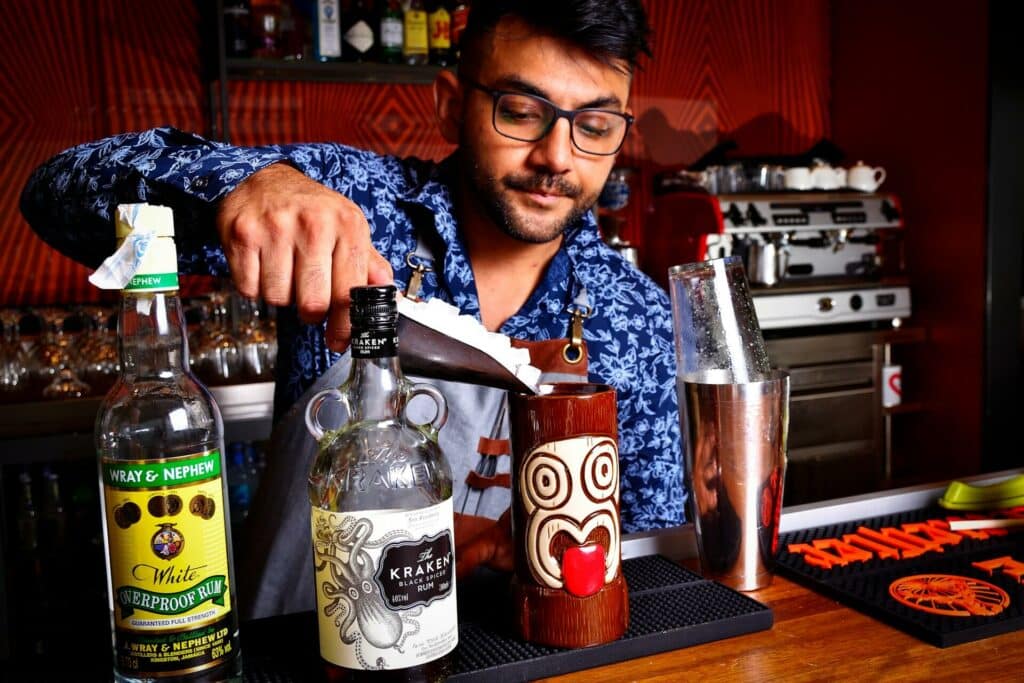If you’re a bartender, chances are you’ve experienced your fair share of aches and pains after a long shift.
I know I have, but it’s part of the job, right? But what if those regular wrist twinges and hand discomfort are pointing to something more serious?
Repetitive wrist movements are part and parcel of the job. But this raises an important question: Can bartending cause carpal tunnel?
For those of us behind the bar, understanding this connection isn’t just about health; it’s about our livelihood.
In this post, we’re taking a thorough look into this matter, equipped with first-hand experience and insights from industry experts.
Can Bartending Cause Carpal Tunnel?
As a bartender, your hands are your most valuable tools. Night after night, you’re shaking cocktails, slicing fruits, and popping open bottles. It’s a relentless cycle of motions that are as repetitive as they are necessary.
No hands. No bartending. I’ve encountered multiple wrist and hand issues over the years that I half attribute to bartending and have even had to stop working for long periods because of it.
Carpal tunnel syndrome (CTS) is a condition that arises from pressure on the median nerve in your wrist, leading to numbness, tingling, and weakness in the hand.
It’s often associated with professions that involve repetitive hand movements, prolonged gripping, and wrist flexion – all of which are familiar territory for bartenders.

Think about it – each cocktail shake, every precise cut of a lime, and the constant clenching of bottle openers, all exert pressure on your wrist.
Over time, this can lead to inflammation and swelling in the narrow passageway of bones and ligaments in your wrist, known as the carpal tunnel.
This swelling can pinch the median nerve, potentially leading to the symptoms of CTS.
But it’s not just the physical actions. Factors like working in awkward positions, not taking enough breaks, and even the ergonomics of your bar setup can contribute to the risk.
So, while bartending doesn’t directly cause carpal tunnel syndrome, the nature of the work certainly puts you in the danger zone.
Do Bartenders Suffer From Wrist Injuries?
When we talk about the occupational hazards of bartending, wrist injuries often top the list.
The reality is, bartenders are at a heightened risk for various wrist-related issues, including strains, sprains, and yes, even carpal tunnel syndrome.
The nature of bartending work involves a lot of repetitive wrist movements – think about the action of shaking a cocktail shaker, stirring drinks, or even just the frequent twisting motion when opening wine bottles or beer taps.
These activities, especially when performed over long shifts without adequate breaks, can put significant strain on the wrist joints and muscles.
It’s also the urgency and speed required in a busy bar environment that can sometimes lead to improper handling or techniques, further increasing the risk of injury.
For example, a bartender might grip a bottle too tightly or use an awkward wrist angle to pour a drink quickly during a rush, both of which can contribute to undue stress on the wrist.
It’s not just the repetitive motions that are worrying. The weight of the items bartenders frequently handle can also be a factor.
Lifting heavy kegs, carrying stacks of dishes, or even the continuous lifting of heavy ice buckets can all contribute to wrist strain.
Below are some common bartender wrist issues that many suffer from:
- Repetitive Strain Injury (RSI)
- Carpal Tunnel Syndrome
- Tendonitis
- Sprains and Strains
- Ganglion Cysts
- De Quervain’s Tenosynovitis
- Trigger Finger/Thumb
- Wrist Bursitis
What Other Injuries Can You Get From Bartending?
When you think of bartending, injuries might not be the first thing that comes to mind. But spend a few shifts behind a busy bar, and you’ll quickly realize it’s not all about mixing drinks and charming customers.
Bartenders often face a range of physical challenges and hazards that can lead to all sorts of injuries.
Ever tried lifting a full keg or a crate of liquor bottles? It’s not exactly light work, and doing it repeatedly can really take a toll on your back and shoulder muscles.
Plus, the long hours on your feet, often with minimal breaks, don’t do your back any favors either.
Then there’s the risk of cuts and lacerations. Working with glassware, especially in a fast-paced environment, always carries the risk of breakage.
It only takes a moment of distraction for a small slip to turn into a painful cut.
Burns are another hazard, though perhaps less obvious. Handling hot liquids, working near steam from coffee machines, or getting a bit too close to a flamed cocktail can result in burns, which are not only painful but can also take you off the roster for a while.
Then there’s the constant danger of slips and falls. Spilled drinks, wet floors – these are just part of a night’s work in a bar.
A slip can lead to anything from a minor bruise to more serious injuries, like fractures or even head injuries if the fall is particularly bad.
As you can see, there are risks involved with bartending that can impact and sometimes deteriorate your health.
Is Carpal Tunnel Common In Bartending?
The short answer is yes, carpal tunnel syndrome is a concern in the bartending industry, but it’s not as cut-and-dried as you might think.
As mentioned earlier, bartending involves a lot of repetitive hand and wrist movements, from shaking cocktails to slicing garnishes, and these actions can contribute to the development of carpal tunnel syndrome over time.

But whether it’s ‘common’ can vary greatly. It depends on factors like how many hours a bartender works, their technique, the ergonomics of their workspace, and even individual physical factors like wrist anatomy or underlying health conditions.
In my own personal experience, it’s a known risk but not necessarily a rampant problem. Some bartenders go through their entire careers without experiencing it, while others might start noticing symptoms early on.
It’s one of those things that’s on our radar, especially during busy seasons when the workload ramps up.
Whilst I can’t say every bartender will face carpal tunnel syndrome, it’s definitely a condition to be aware of and take active steps to prevent.
Wrapping Up
To sum up, while bartending does put you at risk for carpal tunnel syndrome and other wrist-related injuries, it’s not an inevitable fate.
Awareness and preventive measures are key. So pay attention to your technique, take breaks, and set up your workspace ergonomically.
Taking care of your hands and wrists is incredibly important for a sustainable career in bartending.
So stay vigilant and keep your health a top priority.


